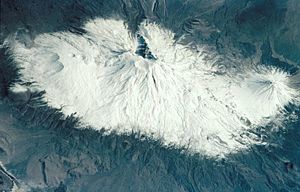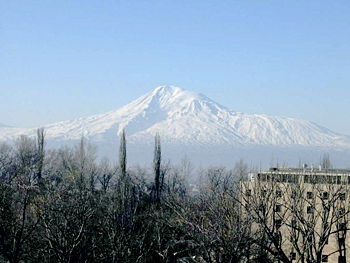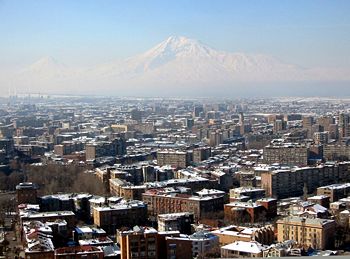Mount Ararat
| Mount Ararat | |
|---|---|
 Satellite picture of Mount Ararat | |
| Elevation | 5,137 metres (16,854 ft) |
| Location | Iğdır Province, Turkey |
| Prominence | 3,611 m ranked 48th |
| Geographic coordinates | 39°42.26′N 44°17.5′E |
| Type | Stratovolcano |
| Last eruption | within the past 10,000 years (theory) |
Mount Ararat (Turkish: Ağrı Dağı, Armenian: Արարատ, Kurdish: Agirî, Greek: Ἀραράτ, Persian: آرارات, Georgian: არარატის, Azeri: Ağrıdağ, Hebrew: אֲרָרָט, Tiberian Hebrew: ʾĂrārāṭ) is the tallest peak in modern Turkey at 5,137 meters (16,854 ft). This snow-capped, dormant volcanic cone is located in the Iğdır Province, near the northeast corner of Turkey, 16 km west of the Iranian and 32 km south of the Armenian border. The name Ağrı in Turkish is said to be derived from Agir in Kurdish meaning fire, referring to Ararat being a volcano. This derivation is uncertain, since there is no historical record of when the volcano was last active and which tribes lived in the vicinity at that time.
Technically, Ararat is a stratovolcano, formed of lava flows and pyroclastic ejecta. A smaller (3,896m) cone, Mount "Sis", also known as "Little Ararat", rises from the same base, southeast of the main peak (Armenians sometimes call the higher peak "Masis"). The lava plateau stretches out between the two pinnacles. The last activity on the mountain was a major earthquake in July 1840 centered around the Ahora Gorge, a northeast trending chasm that drops 1,825 meters (6,000 ft) from the top of the mountain.
The Book of Genesis identifies the "mountains of Ararat" as the resting place of Noah's Ark after the Great Flood described in its text. The Sumerian Epic of Gilgamesh (c. 2000 B.C.E.) also describes a great flood, as does the later record of Berossus (3rd century B.C.E.) and the Koran. The asteroid 96205 Ararat is named in the mountain's honor.
History
Over the centuries, Mount Ararat has been passed back and forth like a [ping-pong]] ball. The first unified state to rule the region surrounding the mountain was ancient Urartu. After the decline of Urartu following invasions by Scythians and the Medes in 585 B.C.E., a semi-independent Armenian state emerged under the rule of the Orontid Dynasty, the members of which frequently intermarried with their overlords, the Achaemenid Persians. After the defeat of the Achaemenids by Alexander the Great in 330 B.C.E., the Orontids gained autonomy, albeit under Macedonian influence.
Antiochus the Great ended Orontid rule in the region when he subjugated Armenia in 201 B.C.E. After the defeat of Antiochus in the Battle of Magnesia, a new independent Armenian Kingdom emerged in 198 B.C.E. that lasted for over six centuries until 428, briefly being annexed to the Roman Empire by Trajan from 114 to 118. Following the partition of the Armenian Kingdom between the Roman Empire and Sassanid Persia in 428, the region was a constant battleground between the two, and afterwards between the Arab Caliphate and the Byzantine Empire.
Ararat was retaken by a new Armenian Kingdom under the Bagratuni Dynasty early in the ninth century C.E., which was annexed by Byzantium in 1045, and then lost the territory to the Seljuk Turks following the Battle of Manzikert in 1071. The Georgian Kingdom took the region from the Seljuks from the late 12th century to the early 13th century, until various Mongol rulers of the Ilkhanate, including Tamerlane, took control of the area in the 13th and 14th centuries. The region was conquered by the Ottoman Empire in 1517 and eventually taken by the Safavids.
Dr. Friedrich Parrot, with the help of Khachatur Abovian, was the first explorer in modern times to reach the summit of Mount Ararat, with the onset of Russian rule in 1829. He was followed in 1856 by a group of five explorers led by Major Robert Stuart.
In 1918, in the aftermath of World War I, the fall of the Ottoman Empire and the October Revolution, the area became part of the Democratic Republic of Armenia, but the republic was short-lived. With the invasion of the Red Army, the area became part of the Soviet Union. Following the Treaty of Kars in 1923, the area was divided between Turkey and the USSR, and the new border, which became internationally recognized, placed Ararat on the Turkish side. Even after this, most Armenians still claimed the mountain. At that time, Armenia was joined together with Georgia and Azerbaijan under the Transcaucasian SFSR. When the TSFSR was dissolved in 1936 and each of the three countries became separate Soviet Republics (Armenian SSR, Azerbaijan SSR, and Georgian SSR), Armenia depicted Ararat on its coat of arms. Turkey protested against this symbolic gesture on the grounds that Ararat was part of its territory, but the Kremlin refused to take action. When Armenia regained its independence from the crumbling Soviet Union in 1991, it formally stated that it did not recognize the Treaty of Kars.
Symbolism
Ararat rises from a flat plain and dominates the skyline of Armenia's capital, Yerevan. Since ancient times, Ararat has been revered by the Armenians as their spiritual home. Today, it is the national symbol of Armenia, where it is sometimes called Masis (Մասիս). Mount Ararat is featured in the center of the Coat of Arms of Armenia. The mountain is often depicted by Armenian artists on paintings, obsidian engravings, backgammon boards and other artifacts. From Yerevan, and throughout much of the country, citizens and tourists get a clear glimpse of both peaks, Mount Ararat and Little Ararat (Sis). Khor Virap, a monastery located just across the border from Turkey, is particularly popular with tourists for its view of the volcano.
In Abrahamic religions, the mountain is also thought to be the place Noah landed after the flood. (Genesis 8:4): "Then the ark rested in the seventh month on the seventeenth day of the month on the mountains of Ararat."
The Ararat anomaly
The Ararat anomaly is an interesting feature located on the northwest corner of the Western Plateau of Mount Ararat (approximately coor dms|39|42|10|N|44|16|30|E|) at about 4,724 meters (15,500 feet), some 2.2 kilometers west of the 5,137 meters (16,854 feet) summit, on the edge of what photographs indicate to be a steep downward slope. It is claimed by a number of Biblical literalists that this anomaly is the remains of Noah's Ark (from the Old Testament).
This ship-shaped feature, resembling a ship's superstructure, has been sized by one satellite imaging expert at 309 meters (1,015 feet) long, as large as today's largest aircraft carriers and would dwarf the Titanic and German battleship Bismarck.
Former intelligence officials say U.S. spy photos
of the odd formation, known as "Ararat Anomaly",
on Turkey's Mt.Ararat could reveal something far
more explosive: the remnants of Noah's Ark, the
ancient vessel from the Bible.
"The pictures are real clear. You see the whole
summit,lots of rock formations," Dino Brugioni,
retired CIA photo specialist, directed to study
the high resolution photos of the unusual site
20 years ago, of Mt.Ararat.
Series of images taken by a U-2 spy plane at the end of a 3,000-mile reconnaissance flight from then Soviet Union to Turkey caught the attention of photo interpreter.
"We measure things, none of them fell within the correct dimensions given in the Bible,"."If we do not have the biblical dimensions in cubits, you could pick up those photos & say they look like a ship. But when you measure it ,it does not come out right...at no time did we say we saw an ark."
For more than 20 years,reconnaissance aircraft & satellites routinely photographed the "Ararat Anomaly". CIA began releasing more detailed high-resolution spy photos of the distinctive formation near the summit.
High level U.S.government interest in the search for Noah's Ark led to CIA's National Photo Interpretation Center (NPIC) of the Ararat Anomoly in the 1970's, & the Defense Intelligence Agency recent analysis.
The Bible tells of God's command to Noah to build an ark 300 cubits in length, 50 cubits wide,& 30 cubits high. A cubit is an ancient measurement of 20~inches, that would make the ark approx.500 feet long, 83.3 feet wide, & 50 feet high.
God made it rain for 40 days " and the water increased and bore up the ark & it rose high above the earth...so mightily upon the earth that all the high mountains under the heavens were covered," per Genesis, the Bible, Torah.
The U-2 photos according to the CIA, of Ararat Anomoly will be released in next few months as part of a batch of hundreds of thousands of spy photos taken on U-2 & SR-71 spy plane missions from the 1950's - mid '70s.
Getting the public to see the photos of Mount Ararat has been a quest of a University of Richmond professor who first heard of rumors about the spy photos of Noah's Ark as a cadet at West Point,in the early '70's.
"Although it is remote that the Ark could survive 4,500 years in a moving glacier, some CIA photo interpreters have not ruled this out," said the professor.
"It doesn't really matter what the anomaly may be", the CIA has photographic evidence that can shed light on the enduring mystery of Mount Ararat, and it has a duty to the public, archaeology and the scientific community to release all the Ararat Anomaly file, be it photos of rocks or a nautical structure of unknown origin."
The late George Carver, a respected top CIA official told a gathering in Florida several years ago "that there were clear indications that there was something up on Mt.Ararat which was rather strange," according to a transcript of his remarks.
The effort finally paid off when the Defense Intelligence Agency in 1995 released aerial photos of the curved formation located about 1.5 miles below the western summit of the peak. The photos were taken by an Air Force plane 1949, June 17.
The DIA produced the analysis of the anomaly using images & a composite "stereo enlargement." According to the report, the site was a combination of shadows, ice and snow.
"The accumulated ice & snow along this precipice obviously fall down the side of the mountain at regular intervals, leaving linear facades," report says. "It appears the "anomaly" is one of these linear facades in the glacial ice underlying recent ice & snow. "The tone & texture of the "anomaly" & avalanche debris immediately below are consistent with that of the shadowed snow, ice & debris prevalent along the face of the precipice."
Other former intelligence officials said later photos including the KH-11 series of spy satellites, provided better views.
Satellite photo of the site produced around 1973 analysts said at the time were surprised when close- ups revealed what looked like three large curved wooden beams, resembling part of the hull of a boat, protruding from the snow.
Enlargements of the spy photos produced what appeared to be "striations" on the formation that gave the appearance of what was once wood, an analyst said.
The search for the ark on Mount Ararat has been greatly complicated & challenging due to the Turkish government closing off the area to visitors, according to the professor. Kurdish rebels & the site's proximity to the border of Armenia & Iran, cited by the government to be the source of danger for tourists.
Historic People of Mount Ararat
The Kurds known as Celali, (pronounced as jee-lah-lee) live a semi-nomadic existence farming sheep on the southern slopes of Ararat. They are part of the 25 million Kurds that live over a five country area. Within this population many ethnic tribes have evolved and the Celali have emerged as one of the largest and strongest, with notoriety for being accomplished fighters. They are predominantly based in the region around the town of Dogubeyazit, the nearest town to Mount Ararat. The language spoken by the Celali is Kurmanji.
Climbing Mount Ararat
The climb is long, but there is a fairly easy route from the South in late summer for climbers who are familiar with the use of axe and crampons. There are two possible campsites on the mountain, and the glacier begins around 4,800 meters. It is difficult for non-Turkish nationals to obtain permission to climb from the Turkish authorities. The process of obtaining permission is quite complicated. For more information, see summitpost.
References in Art and Literature
- The mountain was the setting for the legend of the ten thousand martyrs of Mount Ararat.
- The Armenian-American Metal Band System of a Down wrote the song "Holy Mountains" about Mt. Ararat and its significance to Armenians.
Sources
- Zooming in on Noah's Ark? Satellites Search for Ancient Artifact at space.com
- Satellite Sleuth Closes in on Noah's Ark Mystery at livescience.com
ReferencesISBN links support NWE through referral fees
Ararat, Mount. (2006)Encyclopædia Britannica. Retrieved Sept 6 2006, Encyclopædia Britannica Online Library Edition: http://www.library.eb.com/eb/article-9009204
http://www.noahsarksearch.com/ararat.htm
http://www.noahsarksearch.com/anomaly.htm
http://www.polosbastards.com/artman/publish/Ararat.shtml
Points of Interest
- Ararat anomaly
- Mountains of Ararat, which discusses alternative locations for the landing of Noah's ark
External links
- Mt. Ararat Pictures from Armenia
- Mount Ararat live webcam
- NASA Earth Observatory page
- All About Turkey
- Satellite Sleuth Closes in on Noah's Ark Mystery
- Global Volcanism Program, Mount Ararat page.
- The Mountain of Noah - Biblical references to Mount Ararat
- Noah's Ark Search
- Mount Ararat at Google Maps
- Kurds of Ararat
Credits
New World Encyclopedia writers and editors rewrote and completed the Wikipedia article in accordance with New World Encyclopedia standards. This article abides by terms of the Creative Commons CC-by-sa 3.0 License (CC-by-sa), which may be used and disseminated with proper attribution. Credit is due under the terms of this license that can reference both the New World Encyclopedia contributors and the selfless volunteer contributors of the Wikimedia Foundation. To cite this article click here for a list of acceptable citing formats.The history of earlier contributions by wikipedians is accessible to researchers here:
The history of this article since it was imported to New World Encyclopedia:
Note: Some restrictions may apply to use of individual images which are separately licensed.



